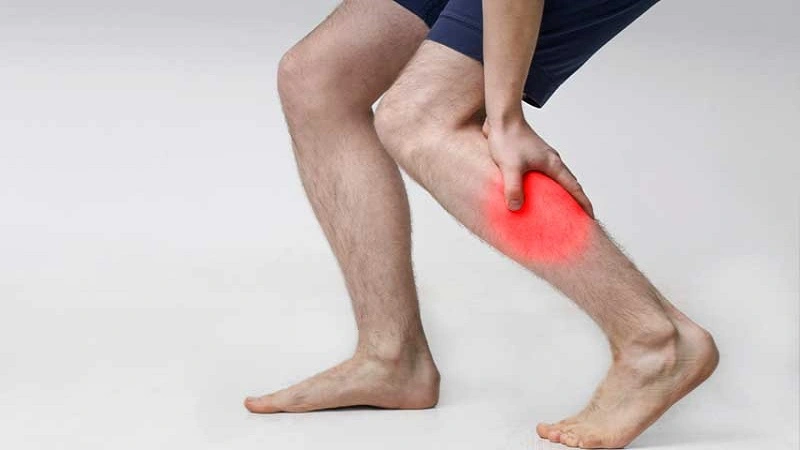Calf pain can be a common issue for many people. Sometimes, it’s simply due to a muscle strain or minor injury, but other times, it could signal a more serious health problem. Knowing when to worry about calf pain is essential for maintaining overall health and preventing complications. In this article, we’ll look at the causes of calf pain, symptoms to watch for, and treatments that can help. By the end, you’ll understand how to tell if your calf pain requires medical attention and what steps to take.
Understanding the Anatomy of the Calf Muscle
Your calf consists of two primary muscles: the gastrocnemius and the soleus. These muscles work together to support your movement, especially in activities like walking, running, and jumping. They connect to the Achilles tendon, which attaches to the heel. When these muscles or tendons become injured or strained, it can result in calf pain.
Understanding the basic anatomy of the calf helps you identify when something feels wrong. In many cases, minor aches will resolve on their own. However, understanding when to worry about calf pain involves knowing the different injuries that can affect these muscles.
Common Causes of Calf Pain

Calf pain can arise from various causes, including:
- Muscle Strain: Overstretching or overusing the calf muscles during exercise or physical activity can lead to strain.
- Cramping: Dehydration, electrolyte imbalances, or prolonged physical activity can cause painful muscle cramps.
- Achilles Tendinitis: Overuse of the Achilles tendon, connecting the calf muscle to the heel, can lead to tendinitis.
- Deep Vein Thrombosis (DVT): A blood clot in a deep vein, often in the leg, is a more serious cause of calf pain.
- Peripheral Artery Disease (PAD): Reduced blood flow to the legs due to narrowed arteries can cause pain, especially during physical activity.
These causes can vary from mild to serious. Knowing when to worry about calf pain means understanding these causes and identifying the symptoms that may accompany them.
Recognizing Symptoms That Require Immediate Attention
Not all calf pain is a cause for concern, but certain symptoms indicate a more severe condition. Seek medical attention if you experience:
- Sudden, Severe Pain: A sudden, sharp pain that doesn’t go away may be due to a muscle tear or rupture.
- Swelling and Redness: Swelling, redness, and warmth in the calf could signal a blood clot, particularly if accompanied by tenderness.
- Pain When Walking: If walking triggers intense pain, it may suggest conditions like PAD or a torn muscle.
- Numbness or Tingling: Calf pain with numbness or tingling could point to nerve involvement, which may require medical evaluation.
- Calf Pain After a Long Flight or Bed Rest: DVT risk is higher after prolonged immobility, so calf pain after a long flight or bed rest should be taken seriously.
Being able to differentiate between regular soreness and serious symptoms is essential in knowing when to worry about calf pain.
Muscle Strain and Cramping: Common and Typically Harmless
Most calf pain results from muscle strain or cramping. Strain occurs when the muscle fibers are stretched or torn, often due to intense exercise. Cramping, meanwhile, may happen due to dehydration or muscle fatigue. While these causes are usually harmless, they can be uncomfortable.
To prevent and treat minor strains or cramps, try the following:
- Stay Hydrated: Drinking plenty of water helps prevent muscle cramps.
- Warm-Up and Cool Down: Proper stretching before and after physical activity helps prevent strain.
- Rest: Give your muscles time to recover after strenuous exercise.
These types of pain are generally short-lived and respond well to rest and hydration. However, if you’re unsure when to worry about calf pain, especially if it doesn’t improve with rest, it’s best to consult a doctor.
Achilles Tendinitis: When Pain Persists at the Back of the Leg
Achilles tendinitis occurs due to overuse of the Achilles tendon. This condition is common in athletes, runners, and people who engage in repetitive leg motions. It typically causes a dull, aching pain at the back of the leg, just above the heel.
Symptoms of Achilles tendinitis include:
- Pain during physical activity
- Stiffness in the tendon, especially in the morning
- Tenderness or swelling along the back of the leg
If you suspect Achilles tendinitis, consider taking a break from activities that aggravate the pain. Physical therapy and exercises can help strengthen the tendon and reduce symptoms. However, prolonged pain and difficulty walking can indicate a more severe condition, such as a tendon tear. Knowing when to worry about calf pain and consult a medical professional is crucial with persistent Achilles tendinitis.
Deep Vein Thrombosis: A Serious Condition to Watch For
Deep vein thrombosis, or DVT, is a serious condition when a blood clot forms in a vein deep within the leg. This can restrict blood flow, causing pain, swelling, and discomfort in the calf. Left untreated, a blood clot can break free and travel to the lungs, resulting in a life-threatening pulmonary embolism.
Symptoms of DVT include:
- Persistent pain or tenderness in the calf
- Swelling in one leg
- Warmth and redness in the affected area
DVT is an example of when to worry about calf pain, as it requires immediate medical intervention. Treatment typically involves blood thinners to prevent the clot from growing. It’s essential to seek medical advice if you suspect DVT, especially if you have a family history of blood clots or other risk factors.
Peripheral Artery Disease: Pain Triggered by Activity
Peripheral artery disease (PAD) occurs when narrowed blood vessels restrict blood flow to the legs. This condition often causes calf pain during physical activity, such as walking, which disappears with rest. Known as “intermittent claudication,” this symptom is a common sign of PAD.
Symptoms of PAD include:
- Cramping pain in the calf that improves with rest
- Coldness or numbness in the lower leg or foot
- Weak pulse in the leg
When left untreated, PAD can increase the risk of heart attack or stroke. If you suspect PAD, it’s crucial to understand when to worry about calf pain and consult a healthcare provider. Lifestyle changes, medication, and, in some cases, surgical procedures may help manage PAD and prevent further complications.
Treatment Options for Calf Pain
Treatment for calf pain depends on its cause. Here are some general approaches:
- Rest and Ice: For muscle strains and tendinitis, rest and ice can reduce inflammation and relieve pain.
- Compression and Elevation: If you experience swelling, compressing the calf and keeping it elevated can reduce discomfort.
- Physical Therapy: Physical therapy exercises can help strengthen the calf muscles and improve mobility.
- Medication: Over-the-counter pain relievers may help with mild pain, while blood thinners are used for DVT treatment.
- Surgery: In severe cases, such as a torn tendon or blocked artery, surgery may be required.
Knowing when to worry about calf pain can ensure you receive timely treatment, preventing further complications and supporting recovery.
When to Seek Medical Attention for Calf Pain

While minor calf pain often resolves with home treatment, there are times when medical attention is necessary. Seek help if:
- Pain doesn’t improve with rest and home care
- Symptoms worsen or spread to other parts of the leg
- Do you experience any DVT symptoms, such as swelling and warmth
- Pain is accompanied by numbness, tingling, or color changes in the leg
A healthcare provider can assess the cause and determine the best treatment plan. Understanding when to worry about calf pain and not ignoring persistent or severe symptoms is essential for preventing complications.
Conclusion: Knowing When to Worry About Calf Pain
Calf pain can range from a minor annoyance to a sign of a serious health issue. While muscle cramps and strains often resolve on their own, conditions like DVT and PAD require medical attention. By learning when to worry about calf pain and recognizing the warning signs, you can take control of your health and seek help when necessary. Always listen to your body and consult a medical professional if you have concerns about calf pain, especially if the pain doesn’t improve with rest and home remedies. Proper care and awareness are key to staying healthy and active.
